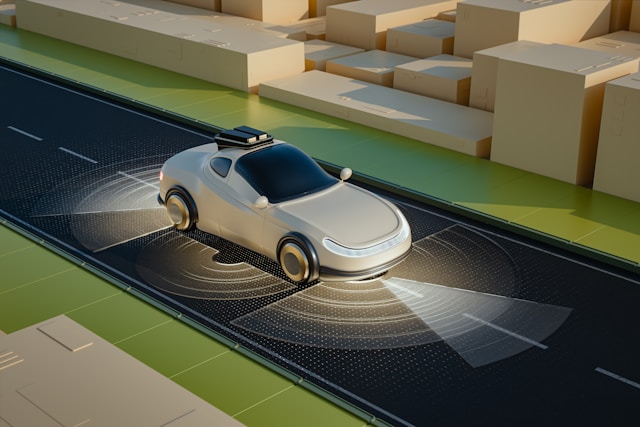a New Era in Transportation
Okay, have you ever been stuck in bumper-to-bumper traffic, wishing you could just teleport to where you need to be? I know we’ve all been there. Well, guess what? The future of transportation is rapidly approaching, and it actually promises a solution to those frustrating commutes. Welcome to the era of self-driving cars! In 2025, we’re not just talking about some distant dream anymore; autonomous driving is becoming a real thing, reshaping how we interact with our roads and cities. I mean, this isn’t just about convenience; it’s a complete revolution affecting everything from our daily commutes to the very design of our urban spaces.

The Rise of Self-Driving Cars: A Market Overview
So, the growth of the self-driving car market by 2025 is, well, it’s nothing short of explosive. What was once kind of a niche concept confined to tech enthusiasts is now a major industry trend. All the major car manufacturers, plus a bunch of tech companies you’ve definitely heard of, are racing to develop and deploy their own versions of this driverless technology. Think about it – no more white-knuckling the steering wheel during rush hour. Instead, you could be catching up on emails, reading a book, or even taking a quick nap! Leading analysts predict that millions of these vehicles will be on the roads within the next few years, you know, transforming from a novelty to a common sight.

Impact on Traffic Congestion and Urban Mobility
I think one of the most exciting promises of self-driving cars is their potential to alleviate the daily gridlock that plagues our cities. The impact of self-driving cars on traffic congestion in 2025 is projected to be pretty significant. Why? Well, because these vehicles can communicate with each other, creating a seamless, coordinated flow of traffic. Vehicular networks use real-time and predict future situations, so adaptive traffic management with autonomous vehicles comes into place, minimizing the stop-and-go patterns that cause so many bottlenecks.
- Traffic lights become obsolete.
- Cars travel closer together safely.
- Accidents due to human error are drastically reduced.

Sounds pretty amazing, right? With smart mobility, we can also use AI in transportation for better real-time route planning, and diversions to avoid future traffic incidents.
Safety Features and Pedestrian Safety
Now, let’s address the elephant in the room: safety. I mean, it’s natural to feel a bit apprehensive about handing over control to a machine. But consider this: human error is the leading cause of most traffic accidents. Safety features of autonomous vehicles in 2025 are actually designed to drastically reduce these risks. We’re talking about:
- 360-degree sensor arrays that constantly monitor the surroundings.
- Advanced AI that can react to hazards faster than any human.
- Redundant systems to ensure that even if one component fails, another takes over.
- The increasing focus on pedestrian safety.
Environmental Impact: Reducing Carbon Emissions
Here’s another compelling reason to embrace self-driving cars: they’re much better for the environment. How self-driving cars reduce carbon emissions is actually multifaceted:
- Optimized driving patterns: Less idling and smoother acceleration/deceleration mean less fuel consumption.
- Electric vehicle synergy: Many self-driving cars are also electric, further reducing emissions. Actually, the rise of electric vehicles goes hand-in-hand with vehicle automation, creating a cleaner, greener transportation system.
- Reduced congestion: Less traffic means less time spent burning fuel unnecessarily.

Cost Benefits and Economic Implications
Let’s talk about your wallet. I mean, the cost benefits of using self-driving cars in 2025 extend beyond just saving on gas. Consider these potential savings:
- Reduced insurance premiums: Fewer accidents mean lower risk, and potentially, lower costs for you.
- Increased productivity: Time spent commuting can be used for work or leisure, right?
- Parking efficiency: Self-driving cars can park themselves in tighter spaces, reducing the need for vast parking lots.
But it’s also worth noting the insurance implications for self-driving cars in 2025. As the technology evolves, so will the insurance models, I guess. Questions around liability in the event of an accident are still being addressed, and new policies are being developed to cover this emerging technology.
Urban Planning and Public Transportation
So, the impact of self-driving cars goes way beyond individual benefits. These urban mobility solutions are actually set to transform our cities. Self-driving cars and urban planning changes are, well, they’re inevitable. We might see:
- Narrower roads, as cars can safely travel closer together.
- More green spaces, as less land is needed for parking.
- Reimagined public transportation systems.
How do you envision autonomous vehicles changing our urban landscape? Speaking of how autonomous vehicles influence public transportation, we may see self-driving buses and shuttles, making public transit more efficient and accessible.
The Role of 5G and AI Integration
The seamless operation of self-driving cars relies heavily on two key technologies: 5G and AI. I mean, the role of 5G technology in self-driving car performance is crucial for real-time data transmission. It enables:
- Instantaneous communication between vehicles.
- Rapid downloads of map and traffic data.
- Reliable connectivity even in densely populated areas.

The integration of AI in self-driving cars 2025 is what makes all of this possible. You know, AI algorithms are the “brains” of the operation, processing vast amounts of data from sensors and making driving decisions in real time. It’s the AI that analyzes the driving environment and, like, facilitates the car’s response in terms of safety and collision avoidance.
Consumer Trust and Overcoming Adoption Barriers
Despite all the advancements, one significant hurdle remains: consumer trust in autonomous driving technology 2025. I mean, it’s understandable to have reservations about a new technology, especially one that involves your safety. So, how do we overcome this?
- Transparency: Manufacturers and regulators need to be open about the technology and its limitations.
- Education: Public awareness campaigns can help people understand the benefits and safety features of self-driving cars.
- Gradual rollout: Allowing people to experience the technology in stages can, you know, build confidence over time.
Regulation and Legal Frameworks
As with any revolutionary technology, self-driving cars require a clear legal and regulatory framework. Regulation of autonomous vehicles in urban areas is a complex issue, with governments worldwide working to establish:
- Safety standards.
- Licensing requirements.
- Liability rules.

Privacy and Data Security Considerations
Finally, let’s address the important topic of privacy and data security in self-driving cars 2025. These vehicles collect a lot of data, and it’s crucial to protect that information. Key considerations include:
- Data ownership: Who owns the data collected by the car?
- Data usage: How is the data being used, and who has access to it?
- Cybersecurity: Protecting the vehicle’s systems from hacking and unauthorized access.
Conclusion: Embracing the Future of Mobility
So, the journey towards a fully autonomous transportation system is a marathon, not a sprint. I mean, there will undoubtedly be challenges and adjustments along the way. But the potential benefits – from safer roads to cleaner air and more efficient cities – are just too significant to ignore. As we move forward, connected cars will be fundamental in vehicle automation. Self-driving cars aren’t just about getting from point A to point B; they’re about reshaping our world for the better. Are you ready to embrace the future of mobility?
